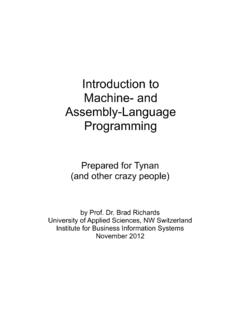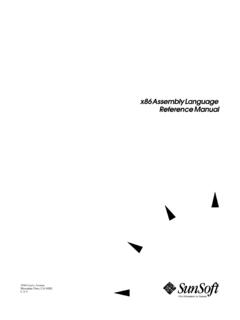Transcription of Open Quantum Assembly Language - arxiv.org
1 Open Quantum Assembly Language Andrew W. Cross, Lev S. Bishop, John A. Smolin, Jay M. Gambetta January 10th, 2017. [quant-ph] 13 Jul 2017. 1 Background Software architectures, compilers, and languages specifically for Quantum computing have been studied by the academic community for more than a decade ([1 4] and references therein). Researchers have implemented software and simulators that can be used in practice to study Quantum algorithms at many scales. While we cannot survey this work here, we list a few of these projects, several of which include software that has been made readily available: Liquid [5, 6], Scaffold [7, 8], Quipper [9 11], ProjectQ [12, 13], QCL [14, 15], Quiddpro [16, 17], Chisel-q [18, 19], and Quil [20, 21].
2 Our goal in this document is to describe an interface Language for the Quantum Expe- rience that enables experiments with small depth Quantum circuits. The Language can be generated by the Composer, hand-written, or targeted by higher level software tools, such as those above. Before we do so, we discuss Quantum programs in general to provide con- text. General Quantum programs require coordination of Quantum and classical parts of the computation. One way to think about general Quantum programs is to identify their distinct phases of execution [11].
3 Fig. 1 shows a high-level diagram of the processes and abstractions involved in specifying a Quantum algorithm, transforming the algorithm into executable form, running an experiment or simulation, and analyzing the results. A key idea throughout these processes is the use of intermediate representations. An intermediate rep- resentation (IR) of a computation is neither its source Language description, nor the target machine instructions , but something in between. Compilers may use several IRs during the process of translating and optimizing a program.
4 Compilation. This phase takes place on a classical computer in a setting where specific problem parameters are not yet known and no interaction with the Quantum computer is required, it is offline. The input is source code describing a Quantum algorithm and any compile time parameters. The output is a combined Quantum /classical program expressed using a high level IR. During this phase, it is possible to compile classical procedures into object code and make initial passes that do not require complete knowledge of the problem parameters.
5 Circuit generation. This takes place on a classical computer in an environment where specific problem parameters are now known, and some interaction with the Quantum com- puter may occur, this is an online phase. The input is a Quantum /classical program expressed using a high level IR, as well as all remaining problem parameters. The output 1. is a collection of Quantum circuits, or Quantum basic blocks, together with associated clas- sical control instructions and classical object code needed at run-time. A basic block is a straight-line code sequence with no branches (except at the entry and exit points).
6 Since feedback can occur on multiple time scales, the Quantum circuits may include instructions for fast feedback. Other classical control instructions outside of the Quantum circuit basic block include, for example, run-time parameter computations and measurement-dependent branches. External classical object code could include algorithms to process measurement outcomes into control flow conditions or results, or to generate new basic blocks on the fly. The output of circuit generation is expressed using a Quantum circuit IR.
7 Further circuit generation may occur based on processed measurement results. Execution. This takes place on physical Quantum computer controllers in a real-time environment, the Quantum computer is active. The input is a collection of Quantum circuits and associated run-time control statements expressed using a Quantum circuit IR. The input is processed by a high-level controller into a stream of real-time instructions in a low-level format that corresponds to physical operations. These are executed on a low-level controller, and a corresponding results stream provides measurement data back to the high-level controller when needed.
8 In general, the high level controller (or virtual machine) can execute classical control instructions and external object code. The output of circuit execution is a collection of processed measurement results returned from the high-level controller. Post-processing. This takes place on a classical computer after all real-time processing is complete. The input is a collection of processed measurement results, and the output is intermediate results for further circuit generation and/or the final result of the Quantum computation.
9 PhaseR1:RcompileRtime PhaseR2:RcircuitRgeneration PhaseR3:RcircuitRexecution Validated Quantum Quantum Quantum System Quantum SystemRstate algorithm PRclassical circuit(s) controlRstream circuit(s). program (+ classical control). (+ classical control). passRto/from selectedRbackends :online2. scheduleRandR parallelRexecution issue :real4time2. :real4time2. HighRlevel System System APIRP SimulationR/ SimulationR/. compilationRand independent dependent Resource ExperimentR ExperimentR. optimization transformations transformations Manager ControllerR:high2 ControllerR:low2.
10 :offline2. useRspecificRproblemRparameters interactRwithRbackends :online2. :offline2 :online2. Analysis Analysis circuit generation Algorithm Requested Processed RawRsystem output results results resultRstream PhaseR4:Rpost4processing Figure 1: Block diagrams of processes (blue) and abstractions (red) to transform and execute a Quantum algorithm. The emphasized Quantum circuit abstraction is the main focus of this document. The API and Resource Manager (green) represents the gateway to backend processes for circuit execution.
![arXiv:0706.3639v1 [cs.AI] 25 Jun 2007](/cache/preview/4/1/3/9/3/1/4/b/thumb-4139314b93ef86b7b4c2d05ebcc88e46.jpg)

![arXiv:1301.3781v3 [cs.CL] 7 Sep 2013](/cache/preview/4/d/5/0/4/3/4/0/thumb-4d504340120163c0bdf3f4678d8d217f.jpg)
![@google.com arXiv:1609.03499v2 [cs.SD] 19 Sep 2016](/cache/preview/c/3/4/9/4/6/9/b/thumb-c349469b499107d21e221f2ac908f8b2.jpg)












